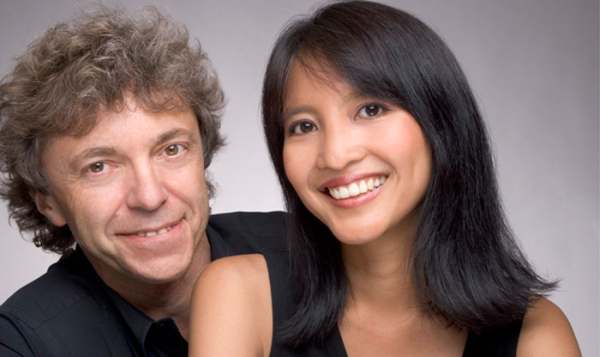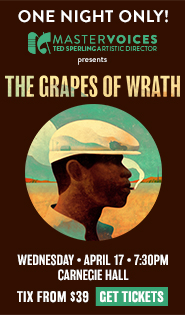Hindson premiere, fine playing surmount acoustical issues at New York Chamber Music Festival

Pascal and Ami Rogé and friends performed music of Bartok, Ravel and Hindson Sunday night at the New York Chamber Music Festival.
Sunday night, out of force of habit, this reviewer walked into the Symphony Space lobby and headed downstairs to the Leonard Nimoy Thalia theater, expecting to find the closing concert of the New York Chamber Music Festival. But the concert, billed as pianist Pascal Rogé and Friends (his wife Ami, also a pianist, and three percussionists from the MET orchestra: Greg Zuber, Duncan Patton and Robert Knopper), was instead upstairs in the Peter Jay Sharp Theatre. Logistically that made sense—the crowd was too large for the combination screening room and concert space—but the Sharp venue caused musical problems that were inconsistently surmounted.
The program was percussion music, not so exotic or unusual if one accepts the piano as a pitched (and sophisticated) percussion instrument, its hammers barely a step removed from a percussionists mallets. The lone piece before intermission was Bartók’s Sonata for Two Pianos and Percussion. One of his finest compositions, the piece is both exacting and imaginative, full of the composer’s typical earthy, rhythmic melodies, and based on classic forms like sonata-allegro and rondo.
The Sonata is also one of the prime examples of Bartók’s personal aesthetic, a balance of exactitude and atmosphere that shifts between mystery and malevolence—the piece might be the ideal soundtrack for Fritz Lang’s Metropolis—and this quality was precisely what was harmed by the theater. The space looks and sounds like a barn, a rough place for chamber music, and the sonic result was a weird and off-putting juxtaposition of cavernous piano tone and dry percussion, especially the wooden xylophone. Throughout the faster opening and closing movements, Zuber (the MET principal percussionist) and Patton (the principal timpanist) struggled to fit their phrases and gestures into those of the pianos, to sound like the music he was making was part of the same space and experience as that coming from the Rogés.
The slow second movement, a kind of night music, was the most successful part of the performance. Balances were ideal and it seemed as if the musicians could hear each other in the same space. The precise playing of the fast movements, impressive by itself, never consistently meshed, with perceptible gaps between the end of percussion phrases and the elision with the pianos—perhaps a case of too many notes going by too fast to be fit together clearly with the proper balance.
The acoustic problems were solved, happily, for the music in second half: Ravel’s Bolero, arranged by the composer for two pianos and percussion, and the American premiere of Pulse Magnet by Australian composer Matthew Hindson.
A seemingly odd choice, Bolero was an unexpected success. The superficial pleasure of the original piece lies in Ravel’s orchestration, the way he moves the single melody around through so many different colors and moods. The monochromatic chamber arrangement forces attention onto the fundamental structure of the piece, repetition with little variation, and the skills of the musicians. Ravel gives them slowly building textures, piano rhythms that gradually add on to the persistent snare drum tattoo, and ramp up in dynamics. With Zuber on the snare, the Rogés played with a subtle accumulation of these musical details, with each moment leading to the retrospective realization that the music had changed dramatically, and that there was still interest and pleasure in the theme.
Hindson’s piece turned out to be the most impressive of the concert. Scored for two pianos and two percussionists, it’s not as fine a composition as Bartók’s objectively, but the musicians—with Knopper at the drum kit—played it like it was the greatest thing they had ever heard. Punchy and pithy, Hindson uses some elements of repetitive minimalism, but primarily meshes rhythmic patterns between the pianos, with complementary ones in the percussion. Zuber had the first word, counting off “1–2–3–4,” and then the music exploded into bright chords, and moved off with the loping pace and power of a locomotive.The piece is full of energy and swagger, and Hindson keeps the textures admirably clear, even when activity is dense.
The musicians honored this with exquisitely exact playing that sacrificed no power. The second movement is almost a pop ballad, with an attractive melody over a rock beat on the drums—Hindson is thinking of Billy Cobham, and Knopper could not quite make it groove. The final movement has interlocking dotted rhythms that might turn towards complex structures in standard minimalism, but Hindson moves the music into more of a barrelhouse piano style, with an excellent drum part (Knopper did groove this one), before winding things up with an exclamation point. The piece and the performance were full of joy.


